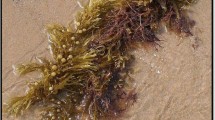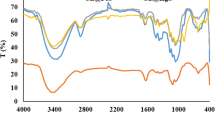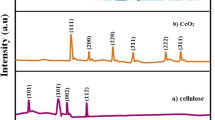Abstract
Cellulose is an excellent natural biopolymer that can be modified to organic-inorganic hybrid nanocomposites by connecting nanomaterials to hydroxyl structure to improve the thermal, morphological, optical and biological properties. Based on the unique properties of oxide materials, we selected SiO2 and ZrO2, which has a large bandgap and a high dielectric constant. To modify the cellulose structure, we used an in-situ sol-gel process to form a cellulose-L-tyrosine (CE-L-tyr) and further synthesized hybrid cellulose-L-tyrosine-SiO2/ZrO2 nanocomposite materials by γ-aminopropyl triethoxysilane (γ-APTES) as coupling agent in the presence of tetraethoxysilane (TEOS) and zirconium isopropoxide. The cellulose-L-tyrosine-SiO2/ZrO2 hybrid nanocomposites were characterized by FTIR, XPS, XRD, UV, TGA, DSC, SEM, EDX and TEM measurements. The different analysis results show the optical transparency, thermal stability, and control morphology of hybrid nanocomposites. From antimicrobial test, CE-L-tyr-SiO2/ZrO2 hybrid nanocomposites exhibit stronger activity against Bacillus cereus and E. coli than that Lactobacillus and Pseudomonas aeruginosa.
Similar content being viewed by others
References
Faruk, O., Bledzki, A. K., Fink, H.-P., and Sain, M., “Biocomposites Reinforced with Natural Fibers: 2000-2010,” Progress in Polymer Science, Vol. 37, No. 11, pp. 1552–1596, 2012.
Yun, S., Kim, J., and Lee, K.-S., “Evaluation of Cellulose Electro-Active Paper Made by Tape Casting and Zone Stretching Methods,” Int. J. Precis. Eng. Manuf., Vol. 11, No. 6, pp. 987–990, 2010.
Lavoine, N., Desloges, I., Dufresne, A., and Bras, J., “Microfibrillated Cellulose-Its Barrier Properties and Applications in Cellulosic Materials: A Review,” Carbohydrate Polymers, Vol. 90, No. 2, pp. 735–764, 2012.
Kim, H. S., Kim, J.-H., and Kim, J., “A Review of Piezoelectric Energy Harvesting Based on Vibration,” Int. J. Precis. Eng. Manuf., Vol. 12, No. 6, pp. 1129–1141, 2011.
Siró, I. and Plackett, D., “Microfibrillated Cellulose and New Nanocomposite Materials: A Review,” Cellulose, Vol. 17, No. 3, pp. 459–494, 2010.
Kim, J.-H., Shim, B. S., Kim, H. S., Lee, Y.-J., Min, S.-K., Jang, D., et al., “Review of Nanocellulose for Sustainable Future Materials,” Int. J. Precis. Eng. Manuf.-Green Tech., Vol. 2, No. 2, pp. 197–213, 2015.
Fortunati, E., Puglia, D., Monti, M., Peponi, L., Santulli, C., et al., “Extraction of Cellulose Nanocrystals from Phormium Tenax Fibres,” Journal of Polymers and the Environment, Vol. 21, No. 2, pp. 319–328, 2013.
Gross, S. and Müller, K., “Sol-Gel Derived Silica-Based Organic-Inorganic Hybrid Materials As “Composite Precursors” for the Synthesis Of Highly Homogeneous Nanostructured Mixed Oxides: An Overview,” Journal of Sol-Gel Science and Technology, Vol. 60, No. 3, pp. 283–298, 2011.
Hou, A., Shi, Y., and Yu, Y., “Preparation of the Cellulose/Silica Hybrid Containing Cationic Group by Sol-Gel Crosslinking Process and Its Dyeing Properties,” Carbohydrate Polymers, Vol. 77, No. 2, pp. 201–205, 2009.
Sanchez, C., Belleville, P., Popall, M., and Nicole, L., “Applications of Advanced Hybrid Organic-Inorganic Nanomaterials: From Laboratory to Market,” Chemical Society Reviews, Vol. 40, No. 2, pp. 696–753, 2011.
Yun, S., Jang, S.-D., Yun, G.-Y., Kim, J.-H., and Kim, J., “Paper Transistor Made with Covalently Bonded Multiwalled Carbon Nanotube and Cellulose,” Applied Physics Letters, Vol. 95, No. 10, Paper No. 104102, 2009.
Ramesh, S. and Kim, J.-H., “Synthesis of Cellulose-L-Tyrosine-Silica Hybrid Nanocomposites by Sol-Gel Process for High Performance Applications,” Journal of Nanoscience and Nanotechnology, Vol. 14, No. 10, pp. 7558–7561, 2014.
Kim, G.-H., Ramesh, S., Kim, J.-H., Jung, D., and Kim, H. S., “Cellulose-Silica/Gold Nanomaterials for Electronic Applications,” Journal of Nanoscience and Nanotechnology, Vol. 14, No. 10, pp. 7495–7501, 2014.
Lin, X.-Z., Ren, T.-Z., and Yuan, Z.-Y., “Mesoporous Zirconium Phosphonate Materials as Efficient Water-Tolerable Solid Acid Catalysts,” Catalysis Science & Technology, Vol. 5, No. 3, pp. 1485–1494, 2015.
Zhang, Y., Pan, L., Gao, C., Wang, Y., and Zhao, Y., “Preparation of ZrO2-SiO2 Mixed Oxide by Combination of Sol-Gel and Alcohol-Aqueous Heating Method and Its Application in Tetrahydrofuran Polymerization,” Journal of Sol-Gel Science and Technology, Vol. 56, No. 1, pp. 27–32, 2010.
Zhan, Z. and Zeng, H. C., “A Catalyst-Free Approach for Sol-Gel Synthesis of Highly Mixed ZrO2-SiO2 Oxides,” Journal of Non-Crystalline Solids, Vol. 243, No. 1, pp. 26–38, 1999.
Tyagi, B., Sidhpuria, K. B., Shaik, B., and Jasra, R. V., “Effect of Zr/Si Molar Ratio and Sulfation on Structural and Catalytic Properties of ZrO2-SiO2 Mixed Oxides,” Journal of Porous Materials, Vol. 17, No. 6, pp. 699–709, 2010.
Saha, S. K. and Pramanik, P., “Aqueous Sol-Gel Synthesis of Powders in the ZrO2-SiO2 System Using Zirconium Formate and Tetraethoxysilane,” Journal of Non-Crystalline Solids, Vol. 159, Nos. 1-2, pp. 31–37, 1993.
Del Monte, F., Larsen, W., and Mackenzie, J. D., “Chemical Interactions Promoting the ZrO2 Tetragonal Stabilization in ZrO2-SiO2 Binary Oxides,” Journal of the American Ceramic Society, Vol. 83, No. 6, pp. 1506–1512, 2000.
Sumana, G., Das, M., Srivastava, S., and Malhotra, B., “A Novel Urea Biosensor Based on Zirconia,” Thin Solid Films, Vol. 519, No. 3, pp. 1187–1191, 2010.
Yang, Y., Yang, H., Yang, M., Shen, G., and Yu, R., “Amperometric Glucose Biosensor Based on a Surface Treated Nanoporous ZrO2/Chitosan Composite Film as Immobilization Matrix,” Analytica Chimica Acta, Vol. 525, No. 2, pp. 213–220, 2004.
Singh, M., Verma, N., Garg, A. K., and Redhu, N., “Urea Biosensors,” Sensors and Actuators B: Chemical, Vol. 134, No. 1, pp. 345–351, 2008.
Debsikdar, J. C., “Transparent Zirconia Gel-Monolith from Zirconium Alkoxide,” Journal of Non-Crystalline Solids, Vol. 86, Nos. 1-2, pp. 231–240, 1986.
Sanchez, C., Livage, J., Henry, M., and Babonneau, F., “Chemical Modification of Alkoxide Precursors,” Journal of Non-Crystalline Solids, Vol. 100, Nos. 1-3, pp. 65–76, 1988.
Chu, W.-S., Kim, C.-S., Lee, H.-T., Choi, J.-O., Park, J.-I., et al., “Hybrid Manufacturing in Micro/Nano Scale: A Review,” Int. J. Precis. Eng. Manuf.-Green Tech., Vol. 1, No. 1, pp. 75–92, 2014.
Shukla, S., Seal, S., Vij, R., and Bandyopadhyay, S., “Effect of HPC and Water Concentration on the Evolution of Size, Aggregation and Crystallization of Sol-Gel Nano Zirconia,” Journal of Nanoparticle Research, Vol. 4, No. 6, pp. 553–559, 2002.
Kim, H. S., Kim, J.-H., and Kim, J., “A Review of Piezoelectric Energy Harvesting Based on Vibration,” Int. J. Precis. Eng. Manuf., Vol. 12, No. 6, pp. 1129–1141, 2011.
Yun, G.-Y., Kim, J.-H., and Kim, J., “Dielectric and Polarization Behaviour of Cellulose Electro-Active Paper (EaPap),” Journal of Physics D: Applied Physics, Vol. 42, No. 8, Paper No. 082003, 2009.
Das-Gupta, D. K. and Doughty, K., “Polymer-Ceramic Composite Materials with High Dielectric Constants,” Thin Solid Films, Vol. 158, No. 1, pp. 93–105, 1988.
Malecki, J. and Hilczer, B., “Dielectric Behaviour of Polymers and Composites,” Key Engineering Materials, Vols. 92-93, pp. 181–216, 1994.
Okubo, T. and Nagamoto, H., “Low-Temperature Preparation of Nanostructured Zirconia and YSZ by Sol-Gel Processing,” Journal of Materials Science, Vol. 30, No. 3, pp. 749–757, 1995.
Baker, C., Pradhan, A., Pakstis, L., Pochan, D. J., and Shah, S. I., “Synthesis and Antibacterial Properties of Silver Nanoparticles,” Journal of Nanoscience and Nanotechnology, Vol. 5, No. 2, pp. 244–249, 2005.
Sulym, I., Goncharuk, O., Sternik, D., Skwarek, E., Derylo- Marczewska, A., et al., “Silica-Supported Titania-Zirconia Nanocomposites: Structural and Morphological Characteristics in Different Media,” Nanoscale Research Letters, Vol. 11, No. 1, pp. 111–120, 2016.
Ahn, S.-H., Chun, D.-M., and Chu, W.-S., “Perspective to Green Manufacturing and Applications,” Int. J. Precis. Eng. Manuf., Vol. 14, No. 6, pp. 873–874, 2013.
Gao, X., Fierro, J., and Wachs, I. E., “Structural Characteristics and Catalytic Properties of Highly Dispersed ZrO2/SiO2 and ViO2/ZrO2/SiO2 Catalysts,” Langmuir, Vol. 15, No. 9, pp. 3169–3178, 1999.
Bae, J.-y., Kim, Y., Kim, H., Kim, Y., Jin, J., and Bae, B.-S., “Ultraviolet Light Stable and Transparent Sol-Gel Methyl Siloxane Hybrid Material for UV Light-Emitting Diode (UV LED) Encapsulant,” ACS Applied Materials & Interfaces, Vol. 7, No. 2, pp. 1035–1039, 2015.
Costa, F., Fregonese, D., Agnello, S., and Cannas, M., “Stability of Sol-Gel Silica Glass for CPV and Ultraviolet LED Applications,” Glass Technology-European Journal of Glass Science and Technology Part A, Vol. 52, No. 6, pp. 185–189, 2011.
Nakamura, N., Sekine, M., Matsumoto, S., Watanabe, K., and Sugimoto, N., “Optical Characteristics of Spherical Glass Encapsulated LEDs,” Journal of the Ceramic Society of Japan, Vol. 116, No. 1358, pp. 1075–1078, 2008.
Scheurell, K., Noack, J., König, R., Hegmann, J., Jahn, R., et al., “Optimisation of a Sol-Gel Synthesis Route for the Preparation of MgF2 Particles for a Large Scale Coating Process,” Dalton Transactions, Vol. 44, No. 45, pp. 19501–19508, 2015.
Jandura, P., Riedl, B., and Kokta, B. V., “Thermal Degradation Behavior of Cellulose Fibers Partially Esterified with Some Long Chain Organic Acids,” Polymer Degradation and Stability, Vol. 70, No. 3, pp. 387–394, 2000.
Yan, Y., Huang, Z., Dong, S., and Jiang, D., “New Route to Synthesize Ultra-Fine Zirconium Diboride Powders Using Inorganic-Organic Hybrid Precursors,” Journal of the American Ceramic Society, Vol. 89, No. 11, pp. 3585–3588, 2006.
Dong, A., Huang, J., Lan, S., Wang, T., Xiao, L., et al., “Synthesis of N-Halamine-Functionalized Silica-Polymer Core-Shell Nanoparticles and their Enhanced Antibacterial Activity,” Nanotechnology, Vol. 22, No. 29, Paper No. 295602, 2011.
Morones, J. R., Elechiguerra, J. L., Camacho, A., Holt, K., Kouri, J. B., et al., “The Bactericidal Effect of Silver Nanoparticles,” Nanotechnology, Vol. 16, No. 10, pp. 2346–2353, 2005.
Seleem, M. N., Munusamy, P., Ranjan, A., Alqublan, H., Pickrell, G., and Sriranganathan, N., “Silica-Antibiotic Hybrid Nanoparticles for Targeting Intracellular Pathogens,” Antimicrobial Agents and Chemotherapy, Vol. 53, No. 10, pp. 4270–4274, 2009.
Li, P., Li, J., Wu, C., Wu, Q., and Li, J., “Synergistic Antibacterial Effects of β-Lactam Antibiotic Combined with Silver Nanoparticles,” Nanotechnology, Vol. 16, No. 9, pp. 1912–1917, 2005.
Ahmed Mosselhy, D., Ge, Y., Gasik, M., Nordström, K., Natri, O., and Hannula, S.-P., “Silica-Gentamicin Nanohybrids,” Vol. 9, No. 3, 170, 2016. (DOI: 10.3390/ma9030170)
Author information
Authors and Affiliations
Corresponding authors
Rights and permissions
About this article
Cite this article
Ramesh, S., Kim, H.S., Lee, YJ. et al. Synthesis of cellulose-L-tyrosine-SiO2/ZrO2 hybrid nanocomposites by sol-gel process and its potential. Int. J. Precis. Eng. Manuf. 18, 1297–1306 (2017). https://doi.org/10.1007/s12541-017-0153-x
Received:
Revised:
Accepted:
Published:
Issue Date:
DOI: https://doi.org/10.1007/s12541-017-0153-x




